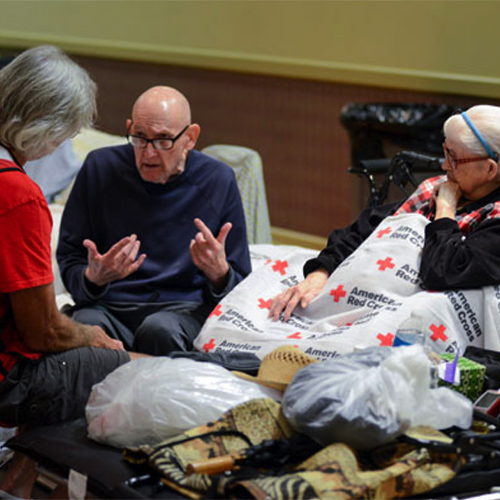 Residents settle into a Houston shelter in advance of Hurricane Harvey. Image Credit: All Stock Photos, 2017.
Residents settle into a Houston shelter in advance of Hurricane Harvey. Image Credit: All Stock Photos, 2017.
By Jolie Breeden, Rachel Adams, Lori Peek, Tracy N. Thomas, and Daire R. Jansson
The word “shelter” conjures thoughts of protection and safety—a haven from whatever storm needs to be weathered. During disasters of all types, shelter is one of the services our nation’s emergency management system strives to provide for those in harm’s way.
Mass shelters—also called evacuation and reception centers, mass care facilities, emergency shelters, and a variety of other names—are a critical, life-saving component of disaster response. Shelters, which are often coordinated by local public health and emergency response agencies with the assistance of the Federal Emergency Management Agency and the Red Cross, provide those who access them with food, clean water, medical care and supplies, and other resources meant to offer stability and comfort during a time of uncertainty. Shelter coordination also involves conducting rapid needs assessments and surveillance to ensure the health and safety of evacuees.
These services are vital because those who access mass shelters are often among the most marginalized in our communities, including people of low socioeconomic status, children and unaccompanied minors, medically fragile people, and those experiencing homelessness. Disasters can exacerbate these social vulnerabilities and contribute to a range of negative health outcomes. But it is also possible to implement evidence-based policies and practices that ameliorate pre-existing inequalities rather than amplify them.
Why a Special Collection on Mass Shelters?
 A nurse checks in on elderly residents at a county health department shelter supported by the Red Cross in Florida. ©Kansas and Oklahoma Red Cross, 2019.
A nurse checks in on elderly residents at a county health department shelter supported by the Red Cross in Florida. ©Kansas and Oklahoma Red Cross, 2019.
Despite careful preparation and coordination, a number of barriers to accessing safe shelters persist. Negative public perceptions of mass shelters can influence whether people shelter in place or evacuate to potentially unsafe locations. Those who do seek safety in a shelter may worry about security, discrimination, or that they will not have access to culturally appropriate accommodations, medicine, or necessary supplies. Individuals and families are often concerned that they may be forced to leave beloved pets behind. Once in a mass shelter, people might not understand what services are available to them. Even when they do, they may be unable to access these services due to long lines, childcare responsibilities, or other obstacles to attaining proper support.
It is imperative that those responsible for coordinating, staffing, supplying, and operating these crucial care facilities have the most up-to-date and accurate information and resources for developing evacuation and shelter plans, supporting operations, and conducting rapid needs assessments and surveillance. This special collection of Research Counts is dedicated to highlighting the findings of leading researchers to help advance such efforts.
Themes in This Collection
Though mass shelters have been established to assist those at risk to and affected by disaster for decades, a recent Government Accountability Office (GAO) report found that there were many opportunities to strengthen how mass shelters in the United States operate.
We have structured this Research Counts Special Collection on Mass Sheltering and Disasters around the many important findings the GAO report brought to light. The articles and the corresponding tools and readings are therefore organized into four overarching themes:
- Roles and Responsibilities for Shelter Operations
- Leveraging Community Groups for Coordination of Mass Care
- Mass Care Delivery and Capability Assessments
- Mass Sheltering for At-Risk Populations
While these themes provide an organizational framework for the special collection, they are meant to be broad and cross-cutting since certain articles and tools transcend multiple themes. In addition, the pieces emphasize the special considerations required to meet the needs of diverse groups who may access shelters after wildfires, hurricanes, tornadoes, and other extreme events. All of the articles exist at the nexus of research and practice.
About This Collection
This special collection of Research Counts—the second such collection developed in partnership between the Natural Hazards Center and the Centers for Disease Control and Prevention—aims to bring recent research on mass shelters to a wide audience. For the first time, a wide array of research on this topic is gathered together in a free, online format, ensuring that crucial research findings are accessible to those who need them most. This effort advances the broader vision for the series, which is designed to share actionable research on the human dimensions of hazards preparedness and mitigation, as well as enduring lessons regarding disaster response and recovery.
The collection includes original briefs from experts in public health and medicine, psychology, sociology, and many other disciplines. The authors have extensive experience studying how coordination of mental and physical health care, the allocation of resources, and many other issues unfold in mass shelter settings. Their contributions detail the ways we can better accommodate and provide potentially life-saving services to all shelter residents. Importantly, the articles also highlight how public health practitioners, emergency managers, and other decision makers can advance planning and response efforts by considering evidence-based recommendations for mass sheltering.
Each contribution includes research insights about shelter planning and mass care provision, as well as a specific callout box to underscore implications for public health practitioners, emergency managers, and other professionals. In addition, our team has prepared a list of tools and suggested further readings that are readily available and freely accessible online. Our hope is that practitioners will be able to use these readings and the associated resources to strengthen planning, communication, collaboration, and service delivery in mass shelter settings.
When a disaster approaches, those in harm’s way must be able to make the choice to seek shelter quickly and decisively. It is vital that data from research is available to help practitioners improve mass sheltering through evidence-informed decision making. This can ultimately reduce human suffering and accelerate the process of recovery.
Research matters, and we want to help make it count.


Jolie Breeden is the lead editor and science communicator for Natural Hazards Center publications. She writes and edits for Research Counts; the Quick Response, Mitigation Matters, Public Health, and Weather Ready Research Award report series; as well as for special projects and publications. Breeden graduated summa cum laude from the University of Colorado Boulder with a bachelor’s degree in journalism.